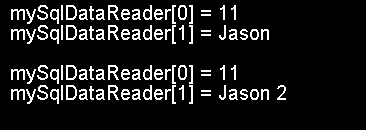Execute multiple SQL statements(insert) using a SqlCommand object

using System;
using System.Data;
using System.Data.SqlClient;
class ExecuteMultipleSQL
{
public static void Main()
{
SqlConnection mySqlConnection =new SqlConnection("server=(local)\\SQLEXPRESS;database=MyDatabase;Integrated Security=SSPI;");
SqlCommand mySqlCommand = mySqlConnection.CreateCommand();
mySqlCommand.CommandText =
"INSERT INTO Employee (ID, FirstName) " +
"VALUES (11, 'Jason');" +
"SELECT ID, FirstName " +
"FROM Employee " +
"WHERE ID = 11;" +
"UPDATE Employee " +
"SET FirstName = 'Jason 2' " +
"WHERE ID = 11;" +
"SELECT ID, FirstName " +
"FROM Employee " +
"WHERE ID = 11;" +
"DELETE FROM Employee " +
"WHERE ID = 11;";
mySqlConnection.Open();
SqlDataReader mySqlDataReader = mySqlCommand.ExecuteReader();
do
{
while (mySqlDataReader.Read())
{
Console.WriteLine("mySqlDataReader[0] = " + mySqlDataReader[0]);
Console.WriteLine("mySqlDataReader[1] = " + mySqlDataReader[1]);
}
Console.WriteLine(""); // visually split the results
} while (mySqlDataReader.NextResult());
mySqlDataReader.Close();
mySqlConnection.Close();
}
}
Related examples in the same category